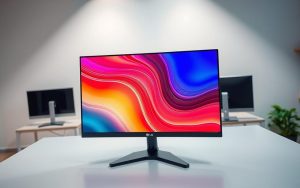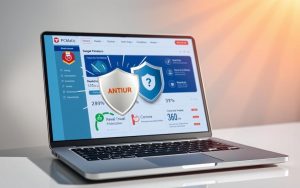Table of Contents
RGB lighting has become a popular feature in modern gaming rigs, but concerns about its long-term effects on hardware are rising. Reports suggest certain LEDs emit low-level UV radiation, which may degrade materials over time.
For instance, Corsair Vengeance RGB modules have been linked to discolored GPU backplates. While glass side panels block most harmful rays, UVA radiation can still penetrate, potentially affecting components like graphics cards.
Balancing aesthetics and safety requires understanding these risks. Compared to sunlight, RGB-related damage is minimal but worth noting for enthusiasts prioritizing longevity.
What Is RGB Lighting and How Does It Work in PCs?
Dynamic color effects elevate PC builds beyond standard functionality. RGB (Red, Green, Blue) lighting lets users customize hues across components like fans, keyboards, and graphics cards. This feature has evolved from static single-color LEDs to advanced addressable systems.
| Type | Voltage | Control | Best For |
|---|---|---|---|
| 12V RGB | 12V | Static colors | Basic setups |
| 5V ARGB | 5V | Per-LED customization | Advanced sync |
Controllers and ARGB headers manage these lighting schemes. Synchronization software ties everything together, enabling effects like wave patterns or temperature-based color shifts.
Beyond aesthetics, RGB serves practical purposes. Some setups change hues when hardware overheats, providing visual alerts. Cooling systems often integrate lighting to indicate fan speeds or airflow efficiency.
From gaming rigs to workstations, customizable illumination enhances both form and function. Proper cable management ensures clean installations without compromising performance.
Does Having Your PC’s Lights On Ruin the Computer? Potential Risks
Modern gaming setups often feature vibrant RGB lighting, but hidden risks may lurk beneath the glow. While these systems enhance visual appeal, prolonged exposure could affect hardware durability. Two primary concerns dominate discussions: UV emissions and thermal effects.

UV Radiation from LEDs: Is Hardware at Risk?
Certain RGB LEDs emit low levels of UVA radiation, which may degrade materials over time. Case studies highlight issues like:
- Corsair Vengeance RGB modules linked to discolored GPU backplates in MSI/Asus systems.
- Plastic yellowing and pigment fading in components near intense lighting zones.
Glass panels block most UVB/UVC rays, but UVA can penetrate, potentially affecting sensitive components. For deeper insights, explore how RGB LEDs impact graphics cards in long-term setups.
Thermal Impact: Do LEDs Contribute to Overheating?
While RGB lighting generates minimal heat, poor installation can exacerbate thermal stress. Key factors include:
- LED drivers adding marginal heat to confined spaces.
- Cable clutter obstructing airflow, raising ambient temperatures.
Compared to CPUs or graphics cards, LED heat output is negligible—typically under 5°C in well-ventilated cases. Proper cable management remains critical to avoid compounding overheating risks.
Balancing aesthetics with damage prevention requires informed choices. Opt for UV-resistant materials and prioritize airflow when designing illuminated builds.
How to Safely Use RGB Lighting in Your PC
UV-filtered lighting solutions minimize risks for enthusiasts prioritizing both style and safety. Smart implementation ensures vibrant colors won’t compromise components like graphics cards or fans.
Choosing the Right RGB Components for Your Setup
Start with UL-certified LED strips featuring UV-blocking coatings. These reduce material degradation risks near heat-sensitive parts. Maintain 1cm clearance between LEDs and critical hardware to prevent thermal interference.
For synchronized effects, Corsair iCUE software offers thermal-based color profiles. This dynamically adjusts hues if temperatures rise, adding a functional layer to aesthetics.
Proper Installation and Cable Management
Anti-static wristbands prevent accidental damage during setup. Secure LEDs with magnetic mounts—adhesive alternatives may leave residue or obstruct airflow.
Route cables along case edges using zip ties. Avoid bundling them near intake fans. PWM-controlled lighting reduces power draw, easing thermal strain.
“Post-installation thermal testing is non-negotiable. Verify ambient temps stay within 5°C of pre-RGB levels.”
Follow these tips to enjoy dazzling RGB without sacrificing longevity or performance.
Long-Term Effects of RGB Lighting on PC Components
Customizable illumination transforms gaming rigs, but long-term exposure raises durability questions. Over years, cumulative effects may alter materials or strain hardware. Understanding these risks ensures balanced builds.

Material Degradation: Can RGB Lights Cause Wear Over Time?
UV emissions from certain RGB LEDs accelerate fading in plastics like ABS and polycarbonate. High-quality dyes resist discoloration for 5+ years, but cheaper alternatives yellow faster. EPROM chips are especially vulnerable, requiring UV-resistant coatings.
Metal components fare better, though prolonged exposure may dull finishes. Thermal cycling from LED heat cycles can weaken adhesives over time. Strategic placement minimizes contact with sensitive parts.
Energy Consumption: Do RGB Lights Significantly Impact Power Usage?
A typical RGB strip draws 2–5W per foot, adding marginal load to PSUs. For context:
- 12V setups consume ~3% of a 650W PSU’s capacity.
- ARGB systems with synchronized colors use 15% less power than static modes.
While negligible for gaming towers, large-scale installations or daisy-chained strips may require higher-wattage units. Always verify total draw against PSU limits.
Conclusion: Balancing Aesthetics and Safety in Your PC Build
Modern RGB setups enhance gaming rigs but demand smart planning. Newer LED models cut UV output by 40%, reducing risks to components. Still, strategic choices ensure both style and safety.
Key steps minimize potential damage:
- Select UV-filtered LEDs from trusted brands like Corsair or CLX Gaming
- Maintain airflow gaps between strips and heat-sensitive parts
- Use synchronization software for thermal-based color alerts
For complex builds, professional installation prevents cable clutter. Emerging technologies now integrate UV-blocking coatings directly into RGB strips. This addition further protects against material degradation.
By prioritizing quality and proper setup, users enjoy vibrant lighting without compromising hardware longevity. Always verify manufacturer testing data before finalizing designs.
FAQ
Can RGB lighting damage PC components over time?
Modern RGB LEDs emit minimal heat and UV radiation, posing little risk to hardware. However, poor-quality components or improper installation may lead to issues like overheating or electrical shorts.
Do RGB lights increase a computer’s internal temperature?
High-quality RGB lighting adds negligible heat. Problems arise only with faulty wiring, blocked airflow, or excessive LED strips interfering with cooling systems.
How do I choose safe RGB components for my build?
Opt for reputable brands like Corsair, NZXT, or ASUS ROG. Ensure compatibility with your motherboard and prioritize components with proper certifications for voltage regulation.
Does RGB lighting significantly raise power consumption?
A typical RGB setup adds only 5-15 watts – less than most case fans. Graphics cards with RGB often draw power from PCIe slots without affecting performance.
Can RGB cables interfere with other components?
Proper cable management prevents obstruction of airflow and component access. Use Velcro ties or dedicated routing channels to keep wiring organized.
Are there materials that degrade under constant RGB exposure?
Premium plastics and metals in modern cases resist discoloration. Cheap acrylic panels may yellow over years of intense blue/UV lighting.
Should I turn off RGB lights when not using my PC?
While unnecessary for hardware safety, disabling lights via software like iCUE or Aura Sync reduces energy use and extends LED lifespan.









